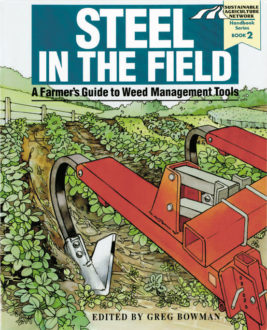The Toolshed - Farmer Sidebars
Gary Thacker
Precision guidance technology can pay its way
Guidance systems that automatically keep cultivators the desired distance from the row greatly relieve operator stress, according to many farmers who use them. Extension Agent Gary Thacker's recent work - as well as agricultural engineer Richard Parish's several years of experience with bedded vegetable crops in Louisiana - show efficiency benefits clustered around greater speed and accuracy.
- Faster cultivating speed reduces labor expense and increases acres covered per day with the same equipment.
- Greater precision widens the inter-row area dependably covered by mechanical weed control and reduces the width of the herbicide band over the row. This cuts chemical cost and use per acre.
- Standardizing width between the outside rows of successive passes nearly eliminates width variance in guess rows. This makes mechanical weed control possible without extra effort for the irregularly spaced rows, and allows the interchangeable use of six-row and four-row equipment in the same field.
Overall, both researchers found that the higher productivity achieved with the guidance systems offsets added costs of the tools in their crop systems.
Dick and Sharon Thompson
Fit cover crops to your farm
The more crops you rotate, the more decisions you have for cover-crop management. Whether you're finding or refining your system, try the checkpoints Iowa farmers Dick and Sharon Thompson use in their search for efficient sustainability:
- Weigh the costs (in labor, expense and possible moisture loss) and benefits (fertility, soil quality and nutrient management, as well as weed control).
- Evaluate: rotation niches; broadcast or drilled establishment; legume or grass species, to respectively fix or recycle nitrogen; and mowing or tillage (or herbicides, if you use them) to kill the covers.
- Determine the most desirable biomass volume and synchronize its arrival with your planting cycle.
While few farmers have the inclination to record data as extensively as do the Thompsons, casually 'trying' a cover crop or other weed-control practice often yields inconclusive results. The Thompsons maximize returns from their on-farm trials by using down-time to carefully study the disciplined, timely observations they make during the crop year.
Your decision-making ability deepens with yearly additions to records on critical points in crop cycles. These include dates for tillage, planting, germination (weed species and crops), spiking through the ground, hoeing and cultivation as well as plant population and weed levels pegged to identifiable crop stages. These data - matched with crop yield and practice costs - provide revealing clues to more profitable weed management economics.
For on-farm research set-up details consult 'The Paired-Comparison: A Good Design for Farmer-Managed Trials,' an excellent (and free) six-page guide from Practical Farmers of Iowa, 2104 Agronomy Hall, ISU, Ames IA 50011; or A Farmer's Guide to On-Farm Research, an 18-page booklet that explains why and how you can gain sharper insights through replicated research.
For the Guide, send $5 to: Rodale Institute Research Publications, 611 Siegfriedale Road, Kutztown PA 19530.
Dick and Sharon Thompson
Ridge-Till Planters Suppress In-Row Weeds
Ridge-till planters do everything no-till planters do - seed a crop into previously untilled soil across many field situations. Yet ridge units can also greatly reduce weed pressure by leaving the row area free of weed seeds that will quickly germinate.
Employing either horizontal disk or sweep-type ridge cleaners, these planters skim all residue and a thin layer of soil from the ridge top. A carefully designed sequence of tooling keeps this weed-seed laden soil flowing away from the row. The remaining planting-zone soil is untilled, leaving its weed seeds below the surface largely unexposed to the light or movement that triggers germination.
By not tilling between harvest and planting, Dick and Sharon Thompson of Boone, Iowa, keep most weed seeds dormant. Another member of the Practical Farmers of Iowa, a farmer group that conducts extensive on-farm testing of sustainable practices, recorded 90 percent fewer weeds (in-row at harvest) in ridge-till compared with conventional tillage. Thompson's tests show that any type of tillage prior to planting increases weed pressure.
A runner-type seed opener works well in the moist soil conditions he often encounters at planting. Disk openers are effective in dry, trashy conditions but plug more often in moist soil, he reports.
Rex and Glenn Spray
Disking down clover secures sloping soil
COSHOCTON, Ohio - A friable, crumbly soil structure minimizes runoff despite a relatively low residue cover, a phenomenon documented in work at the USDA-ARS hydrologic station here. The site is about 40 miles east of the Knox County farm of Rex and Glenn Spray, and used even steeper slopes for a test that verified the effectiveness of their system.
Soil scientists concluded a six-year study in 1996 that compared disked and cultivated plots with herbicide-treated plots that were chisel-plowed and no-tilled, all on steeply sloping fields. Results showed that corn yields and erosion control in their disked plots were better than or comparable to the other two systems.
The experiment used a three-year rotation of corn, soybeans and wheat/red clover. All treatments received solid beef-cattle manure and only 50 pounds of actual N. Herbicides were applied at half-rate. Technicians disked the mechanical weed control plots to prepare seedbeds two out of three years, cultivated annually for weed control, and used a rotary hoe as needed to relieve soil crusting.
Soil scientist Dr. Bill Edwards, former director at the Coshocton station, commented on the study. 'Light disking that incorporates the manure and red-clover sod residue into the top three inches of soil, along with the soil aggregates the clover helps to create, can produce good crops at a good profit. Our grandfathers knew how to do it. We can figure it out, too.'
